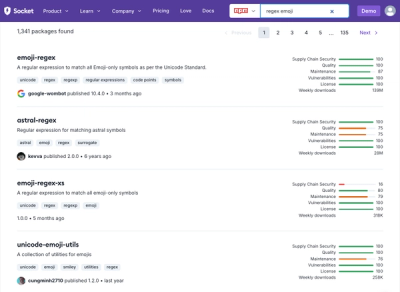
Research
Security News
Malicious npm Package Targets Solana Developers and Hijacks Funds
A malicious npm package targets Solana developers, rerouting funds in 2% of transactions to a hardcoded address.
**HonoX** is a simple and fast meta-framework for creating full-stack websites or Web APIs - (formerly _[Sonik](https://github.com/sonikjs/sonik)_). It stands on the shoulders of giants; built on [Hono](https://hono.dev/), [Vite](https://vitejs.dev/), and
HonoX is a simple and fast meta-framework for creating full-stack websites or Web APIs - (formerly Sonik). It stands on the shoulders of giants; built on Hono, Vite, and UI libraries.
Note: HonoX is currently in the "alpha stage". Breaking changes are introduced without following semantic versioning.
You can install the honox package from the npm.
npm install hono honox
If you are starting a new HonoX project, use the hono-create command. Run the following and choose x-basic (use the arrow keys to find the option).
npm create hono@latest
Let's create a basic HonoX application using hono/jsx as a renderer. This application has no client JavaScript and renders JSX on the server side.
Below is a typical project structure for a HonoX application.
.
├── app
│ ├── global.d.ts // global type definitions
│ ├── routes
│ │ ├── _404.tsx // not found page
│ │ ├── _error.tsx // error page
│ │ ├── _renderer.tsx // renderer definition
│ │ ├── about
│ │ │ └── [name].tsx // matches `/about/:name`
│ │ └── index.tsx // matches `/`
│ └── server.ts // server entry file
├── package.json
├── tsconfig.json
└── vite.config.ts
vite.config.tsThe minimum Vite setup for development is as follows:
import { defineConfig } from 'vite'
import honox from 'honox/vite'
export default defineConfig({
plugins: [honox()],
})
A server entry file is required. The file should be placed at app/server.ts. This file is first called by the Vite during the development or build phase.
In the entry file, simply initialize your app using the createApp() function. app will be an instance of Hono, so you can use Hono's middleware and the showRoutes() in hono/dev.
// app/server.ts
import { createApp } from 'honox/server'
import { showRoutes } from 'hono/dev'
const app = createApp()
showRoutes(app)
export default app
There are three ways to define routes.
createRoute()Each route should return an array of Handler | MiddlewareHandler. createRoute() is a helper function to return it. You can write a route for a GET request with default export.
// app/routes/index.tsx
// `createRoute()` helps you create handlers
import { createRoute } from 'honox/factory'
export default createRoute((c) => {
return c.render(
<div>
<h1>Hello!</h1>
</div>
)
})
You can also handle methods other than GET by export POST, PUT, and DELETE.
// app/routes/index.tsx
import { createRoute } from 'honox/factory'
import { getCookie, setCookie } from 'hono/cookie'
export const POST = createRoute(async (c) => {
const { name } = await c.req.parseBody<{ name: string }>()
setCookie(c, 'name', name)
return c.redirect('/')
})
export default createRoute((c) => {
const name = getCookie(c, 'name') ?? 'no name'
return c.render(
<div>
<h1>Hello, {name}!</h1>
<form method='POST'>
<input type='text' name='name' placeholder='name' />
<input type='submit' />
</form>
</div>
)
})
You can create API endpoints by exporting an instance of the Hono object.
// app/routes/about/index.ts
import { Hono } from 'hono'
const app = new Hono()
// matches `/about/:name`
app.get('/:name', (c) => {
const name = c.req.param('name')
return c.json({
'your name is': name,
})
})
export default app
Or simply, you can just return JSX.
// app/routes/index.tsx
export default function Home(_c: Context) {
return <h1>Welcome!</h1>
}
Define your renderer - the middleware that does c.setRender() - by writing it in _renderer.tsx.
Before writing _renderer.tsx, write the Renderer type definition in global.d.ts.
// app/global.d.ts
import type {} from 'hono'
type Head = {
title?: string
}
declare module 'hono' {
interface ContextRenderer {
(content: string | Promise<string>, head?: Head): Response | Promise<Response>
}
}
The JSX Renderer middleware allows you to create a Renderer as follows:
// app/routes/_renderer.tsx
import { jsxRenderer } from 'hono/jsx-renderer'
export default jsxRenderer(({ children, title }) => {
return (
<html lang='en'>
<head>
<meta charset='UTF-8' />
<meta name='viewport' content='width=device-width, initial-scale=1.0' />
{title ? <title>{title}</title> : <></>}
</head>
<body>{children}</body>
</html>
)
})
The _renderer.tsx is applied under each directory, and the app/routes/posts/_renderer.tsx is applied in app/routes/posts/*.
You can write a custom Not Found page in _404.tsx.
// app/routes/_404.tsx
import { NotFoundHandler } from 'hono'
const handler: NotFoundHandler = (c) => {
return c.render(<h1>Sorry, Not Found...</h1>)
}
export default handler
You can write a custom Error page in _error.tsx.
// app/routes/_error.tsx
import { ErrorHandler } from 'hono'
const handler: ErrorHandler = (e, c) => {
return c.render(<h1>Error! {e.message}</h1>)
}
export default handler
Let's create an application that includes a client side. Here, we will use hono/jsx/dom.
Below is the project structure of a minimal application including a client side:
.
├── app
│ ├── client.ts // client entry file
│ ├── global.d.ts
│ ├── islands
│ │ └── counter.tsx // island component
│ ├── routes
│ │ ├── _renderer.tsx
│ │ └── index.tsx
│ └── server.ts
├── package.json
├── tsconfig.json
└── vite.config.ts
This is a _renderer.tsx, which will load the /app/client.ts entry file for the client. It will load the JavaScript file for production according to the variable import.meta.env.PROD. And renders the inside of <HasIslands /> if there are islands on that page.
// app/routes/_renderer.tsx
import { jsxRenderer } from 'hono/jsx-renderer'
import { HasIslands } from 'honox/server'
export default jsxRenderer(({ children }) => {
return (
<html lang='en'>
<head>
<meta charset='UTF-8' />
<meta name='viewport' content='width=device-width, initial-scale=1.0' />
{import.meta.env.PROD ? (
<HasIslands>
<script type='module' src='/static/client.js'></script>
</HasIslands>
) : (
<script type='module' src='/app/client.ts'></script>
)}
</head>
<body>{children}</body>
</html>
)
})
If you have a manifest file in dist/.vite/manifest.json, you can easily write it using <Script />.
// app/routes/_renderer.tsx
import { jsxRenderer } from 'hono/jsx-renderer'
import { Script } from 'honox/server'
export default jsxRenderer(({ children }) => {
return (
<html lang='en'>
<head>
<meta charset='UTF-8' />
<meta name='viewport' content='width=device-width, initial-scale=1.0' />
<Script src='/app/client.ts' />
</head>
<body>{children}</body>
</html>
)
})
Note: Since <HasIslands /> can slightly affect build performance when used, it is recommended that you do not use it in the development environment, but only at build time. <Script /> does not cause performance degradation during development, so it's better to use it.
If you want to add a nonce attribute to <Script /> or <script /> element, you can use Security Headers Middleware.
Define the middleware:
// app/routes/_middleware.ts
import { createRoute } from 'honox/factory'
import { secureHeaders, NONCE } from 'hono/secure-headers'
secureHeaders({
contentSecurityPolicy: import.meta.env.PROD
? {
scriptSrc: [NONCE],
}
: undefined,
})
You can get the nonce value with c.get('secureHeadersNonce'):
// app/routes/_renderer.tsx
import { jsxRenderer } from 'hono/jsx-renderer'
import { Script } from 'honox/server'
export default jsxRenderer(({ children }, c) => {
return (
<html lang='en'>
<head>
<Script src='/app/client.ts' async nonce={c.get('secureHeadersNonce')} />
</head>
<body>{children}</body>
</html>
)
})
A client-side entry file should be in app/client.ts. Simply, write createClient().
// app/client.ts
import { createClient } from 'honox/client'
createClient()
If you want to add interactions to your page, create Island components. Islands components should be:
app/islands directory or named with $ prefix like $componentName.tsx.default or a proper component name that uses camel case but does not contain _ and is not all uppercase.For example, you can write an interactive component such as the following counter:
// app/islands/counter.tsx
import { useState } from 'hono/jsx'
export default function Counter() {
const [count, setCount] = useState(0)
return (
<div>
<p>Count: {count}</p>
<button onClick={() => setCount(count + 1)}>Increment</button>
</div>
)
}
When you load the component in a route file, it is rendered as Server-Side rendering and JavaScript is also sent to the client side.
// app/routes/index.tsx
import { createRoute } from 'honox/factory'
import Counter from '../islands/counter'
export default createRoute((c) => {
return c.render(
<div>
<h1>Hello</h1>
<Counter />
</div>
)
})
Note: You cannot access a Context object in Island components. Therefore, you should pass the value from components outside of the Island.
import { useRequestContext } from 'hono/jsx-renderer'
import Counter from '../islands/counter.tsx'
export default function Component() {
const c = useRequestContext()
return <Counter init={parseInt(c.req.query('count') ?? '0', 10)} />
}
You can bring your own renderer using a UI library like React, Preact, Solid, or others.
Note: We may not provide support for the renderer you bring.
You can define a renderer using @hono/react-renderer. Install the modules first.
npm i @hono/react-renderer react react-dom hono
npm i -D @types/react @types/react-dom
Define the Props that the renderer will receive in global.d.ts.
// global.d.ts
import '@hono/react-renderer'
declare module '@hono/react-renderer' {
interface Props {
title?: string
}
}
The following is an example of app/routes/_renderer.tsx.
// app/routes/_renderer.tsx
import { reactRenderer } from '@hono/react-renderer'
export default reactRenderer(({ children, title }) => {
return (
<html lang='en'>
<head>
<meta charSet='UTF-8' />
<meta name='viewport' content='width=device-width, initial-scale=1.0' />
{import.meta.env.PROD ? (
<script type='module' src='/static/client.js'></script>
) : (
<script type='module' src='/app/client.ts'></script>
)}
{title ? <title>{title}</title> : ''}
</head>
<body>{children}</body>
</html>
)
})
The app/client.ts will be like this.
// app/client.ts
import { createClient } from 'honox/client'
createClient({
hydrate: async (elem, root) => {
const { hydrateRoot } = await import('react-dom/client')
hydrateRoot(root, elem)
},
createElement: async (type: any, props: any) => {
const { createElement } = await import('react')
return createElement(type, props)
},
})
Configure react in vite.config.ts.
// vite.config.ts
import build from '@hono/vite-build/cloudflare-pages'
import honox from 'honox/vite'
import { defineConfig } from 'vite'
export default defineConfig(({ mode }) => {
if (mode === 'client') {
return {
build: {
rollupOptions: {
input: ['./app/client.ts'],
output: {
entryFileNames: 'static/client.js',
chunkFileNames: 'static/assets/[name]-[hash].js',
assetFileNames: 'static/assets/[name].[ext]',
},
},
emptyOutDir: false,
},
}
} else {
return {
ssr: {
external: ['react', 'react-dom'],
},
plugins: [honox(), build()],
}
}
})
Adjust tsconfig.json jsx factory function option.
// tsconfig.json
{
"compilerOptions": {
...
"jsxImportSource": "react"
...
}
}
If you are using the JSX Renderer middleware, you can nest layouts using <Layout />.
// app/routes/posts/_renderer.tsx
import { jsxRenderer } from 'hono/jsx-renderer'
export default jsxRenderer(({ children, Layout }) => {
return (
<Layout>
<nav>Posts Menu</nav>
<div>{children}</div>
</Layout>
)
})
Props passed to nested renderers do not automatically propagate to the parent renderers. To ensure that the parent layouts receive the necessary props, you should explicitly pass them from the nested component. Here's how you can achieve that:
Let's start with our route handler:
// app/routes/nested/index.tsx
export default createRoute((c) => {
return c.render(<div>Content</div>, { title: 'Dashboard' })
})
Now, let's take a look at our nested renderer:
// app/routes/nested/_renderer.tsx
export default jsxRenderer(({ children, Layout, title }) => {
return (
<Layout title={title}>
{/* Pass the title prop to the parent renderer */}
<main>{children}</main>
</Layout>
)
})
In this setup, all the props sent to the nested renderer's are consumed by the parent renderer:
// app/routes/_renderer.tsx
export default jsxRenderer(({ children, title }) => {
return (
<html lang='en'>
<head>
<title>{title}</title> {/* Use the title prop here */}
</head>
<body>
{children} {/* Insert the Layout's children here */}
</body>
</html>
)
})
You can use Hono's Middleware in each root file with the same syntax as Hono. For example, to validate a value with the Zod Validator, do the following:
import { z } from 'zod'
import { zValidator } from '@hono/zod-validator'
const schema = z.object({
name: z.string().max(10),
})
export const POST = createRoute(zValidator('form', schema), async (c) => {
const { name } = c.req.valid('form')
setCookie(c, 'name', name)
return c.redirect('/')
})
Alternatively, you can use a _middleware.(ts|tsx) file in a directory to have that middleware applied to the current route, as well as all child routes. Middleware is run in the order that it is listed within the array.
// /app/routes/_middleware.ts
import { createRoute } from 'honox/factory'
import { logger } from 'hono/logger'
import { secureHeaders } from 'hono/secure-headers'
export default createRoute(logger(), secureHeaders(), ...<more-middleware>)
By default, trailing slashes are removed if the root file is an index file such as index.tsx or index.mdx.
However, if you set the trailingSlash option to true as the following, the trailing slash is not removed.
import { createApp } from 'honox/server'
const app = createApp({
trailingSlash: true,
})
Like the followings:
trailingSlash is false (default): app/routes/path/index.mdx => /pathtrailingSlash is true: app/routes/path/index.mdx => /path/Given that HonoX is Vite-centric, if you wish to utilize Tailwind CSS, simply adhere to the official instructions.
Prepare tailwind.config.js and postcss.config.js:
// tailwind.config.js
export default {
content: ['./app/**/*.tsx'],
theme: {
extend: {},
},
plugins: [],
}
// postcss.config.js
export default {
plugins: {
tailwindcss: {},
autoprefixer: {},
},
}
Write app/style.css:
@tailwind base;
@tailwind components;
@tailwind utilities;
Import it in a renderer file. Using the Link component will refer to the correct CSS file path after it is built.
// app/routes/_renderer.tsx
import { jsxRenderer } from 'hono/jsx-renderer'
import { Link } from 'honox/server'
export default jsxRenderer(({ children }) => {
return (
<html lang='en'>
<head>
<meta charset='UTF-8' />
<meta name='viewport' content='width=device-width, initial-scale=1.0' />
<Link href='/app/style.css' rel='stylesheet' />
</head>
<body>{children}</body>
</html>
)
})
Finally, add vite.config.ts configuration to output assets for the production.
import honox from 'honox/vite'
import { defineConfig } from 'vite'
import build from '@hono/vite-build/cloudflare-pages'
export default defineConfig({
plugins: [
honox({
client: {
input: ['/app/style.css'],
},
}),
build(),
],
})
MDX can also be used. Here is the vite.config.ts.
import devServer from '@hono/vite-dev-server'
import mdx from '@mdx-js/rollup'
import honox from 'honox/vite'
import remarkFrontmatter from 'remark-frontmatter'
import remarkMdxFrontmatter from 'remark-mdx-frontmatter'
import { defineConfig } from 'vite'
export default defineConfig(() => {
return {
plugins: [
honox(),
mdx({
jsxImportSource: 'hono/jsx',
remarkPlugins: [remarkFrontmatter, remarkMdxFrontmatter],
}),
],
}
})
Blog site can be created.
// app/routes/index.tsx
import type { Meta } from '../types'
export default function Top() {
const posts = import.meta.glob<{ frontmatter: Meta }>('./posts/*.mdx', {
eager: true,
})
return (
<div>
<h2>Posts</h2>
<ul class='article-list'>
{Object.entries(posts).map(([id, module]) => {
if (module.frontmatter) {
return (
<li>
<a href={`${id.replace(/\.mdx$/, '')}`}>{module.frontmatter.title}</a>
</li>
)
}
})}
</ul>
</div>
)
}
If you want to use Cloudflare's Bindings in your development environment, create wrangler.toml and configure it properly.
name = "my-project-name"
compatibility_date = "2024-04-01"
compatibility_flags = [ "nodejs_compat" ]
pages_build_output_dir = "./dist"
# [vars]
# MY_VARIABLE = "production_value"
# [[kv_namespaces]]
# binding = "MY_KV_NAMESPACE"
# id = "xxxxxxxxxxxxxxxxxxxxxxxxxxxxxxxx"
In vite.config.ts, use the Cloudflare Adapter in @hono/vite-dev-server.
import honox from 'honox/vite'
import adapter from '@hono/vite-dev-server/cloudflare'
import { defineConfig } from 'vite'
export default defineConfig({
plugins: [
honox({
devServer: {
adapter,
},
}),
],
})
Since a HonoX instance is essentially a Hono instance, it can be deployed on any platform that Hono supports.
Add the wrangler.toml:
# wrangler.toml
name = "my-project-name"
compatibility_date = "2024-04-01"
compatibility_flags = [ "nodejs_compat" ]
pages_build_output_dir = "./dist"
Setup the vite.config.ts:
// vite.config.ts
import { defineConfig } from 'vite'
import honox from 'honox/vite'
import build from '@hono/vite-build/cloudflare-pages'
export default defineConfig({
plugins: [honox(), build()],
})
Build command (including a client):
vite build --mode client && vite build
Deploy with the following commands after the build. Ensure you have Wrangler installed:
wrangler pages deploy
Using Hono's SSG feature, you can generate static HTML for each route.
import { defineConfig } from 'vite'
import honox from 'honox/vite'
import ssg from '@hono/vite-ssg'
const entry = './app/server.ts'
export default defineConfig(() => {
return {
plugins: [honox(), ssg({ entry })],
}
})
If you want to include client-side scripts and assets:
// vite.config.ts
import ssg from '@hono/vite-ssg'
import honox from 'honox/vite'
import client from 'honox/vite/client'
import { defineConfig } from 'vite'
const entry = './app/server.ts'
export default defineConfig(({ mode }) => {
if (mode === 'client') {
return {
plugins: [client()],
}
} else {
return {
build: {
emptyOutDir: false,
},
plugins: [honox(), ssg({ entry })],
}
}
})
Build command (including a client):
vite build --mode client && vite build
You can also deploy it to Cloudflare Pages.
wrangler pages deploy ./dist
Using @hono/vite-build, you can build the HonoX app for various platforms. For example, you can make it for the Bun:
// vite.config.ts
import { defineConfig } from 'vite'
import honox from 'honox/vite'
import build from '@hono/vite-build/bun'
export default defineConfig({
plugins: [honox(), build()],
})
MIT
FAQs
**HonoX** is a simple and fast meta-framework for creating full-stack websites or Web APIs - (formerly _[Sonik](https://github.com/sonikjs/sonik)_). It stands on the shoulders of giants; built on [Hono](https://hono.dev/), [Vite](https://vitejs.dev/), and
We found that honox demonstrated a healthy version release cadence and project activity because the last version was released less than a year ago. It has 0 open source maintainers collaborating on the project.
Did you know?

Socket for GitHub automatically highlights issues in each pull request and monitors the health of all your open source dependencies. Discover the contents of your packages and block harmful activity before you install or update your dependencies.

Research
Security News
A malicious npm package targets Solana developers, rerouting funds in 2% of transactions to a hardcoded address.

Security News
Research
Socket researchers have discovered malicious npm packages targeting crypto developers, stealing credentials and wallet data using spyware delivered through typosquats of popular cryptographic libraries.

Security News
Socket's package search now displays weekly downloads for npm packages, helping developers quickly assess popularity and make more informed decisions.